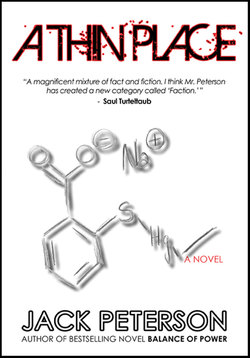Читать книгу A Thin Place - Jack Peterson - Страница 4
На сайте Литреса книга снята с продажи.
From the author…
ОглавлениеThis is the second printing of A Thin Place, a novel inspired by a true story of a four-year-old autistic girl with a talent so unique that more than one art historian claimed that her sketches could easily be mistaken to have come from the hand of Leonardo da Vinci. This story was nothing more than an embryonic idea for a very long time because I knew that creating such a novel required my having a far better understanding of the intricacies of autism. That research took over two years and led the novel’s storyline down a far different trail than originally intended.
I have made every effort to ensure that A Thin Place is historically accurate as it relates to autism. All information regarding the myriad and controversial issues surrounding the malady (including the use of mercury as a preservative in vaccines) and treatments for autism come from publicly available documents. You will find that the novel’s fictional characters frequently surrounded by recognizable public personalities and elected officials. Wherever possible, real events and documentable statements are used to support the plot and have not been distorted in any way.
The word autism was first coined by Swiss psychiatrist Eugen Bleuler in 1911. Over thirty years later, early-childhood development pioneers Leo Kanner and Hans Asperger each published separate and uniquely different studies on autism. It should be noted that prior their academic publications (despite psychology books dating back hundreds of years) no recorded history of anything resembling what we now commonly call autism existed.
Autism rates have skyrocketed throughout the world and myriad theories regarding the cause of those tragic increases are never one-sided conversations. Unfortunately, for most of us, our general understanding of autism has not kept up with the vast medical research and information available today. Children with autism are not unruly youngsters who simply choose misbehave. Fortunately, unlike when the malady was discovered, the children are no longer swept off to an asylum. More often than not, autistic children lead happy and productive lives when provided appropriate support. Truth is, many children remain without the luxury of proper care.
An intense debate still rages over the correlation between the rising autism prevalence in the U.S. and the current mandated vaccine schedule. At the center of the debate has been (and still is) the use of a mercury-based vaccine preservative formula that until recently was used in many childhood vaccines (it remains in most flu vaccines). Those claiming such a correlation between vaccines and the skyrocketing autism rates in the last twenty years often cite that the United States has the most aggressive mandated vaccine schedule for children in the Western world, a number that is double the average of most countries. It is a schedule that has grown dramatically over the years (25 additional vaccines added since 1990). An interesting aside is that all countries with lower vaccine mandates than those in the U.S. have significantly lower autism rates. The facts are that in 1983 the U.S. vaccine schedule recommended by the Centers for Disease Control for children aged five and under was 1o. That number has nearly tripled as of this writing to the recommended 36 vaccinations for the same age group and some of those vaccines, flu for example, still contain mercury preservatives.
Written first to entertain and second to educate, the treatment and causation theories concerning autism are included to support the storyline. A conscious effort was made to ensure the reader does not feel as if they are reading a textbook and to do it without compromising historical accuracy. I believe we have done that and there is a material benefit. When you turn the last page, your grasp of the intricacies and controversies surrounding autism will likely be higher than 99% of the world’s population!
